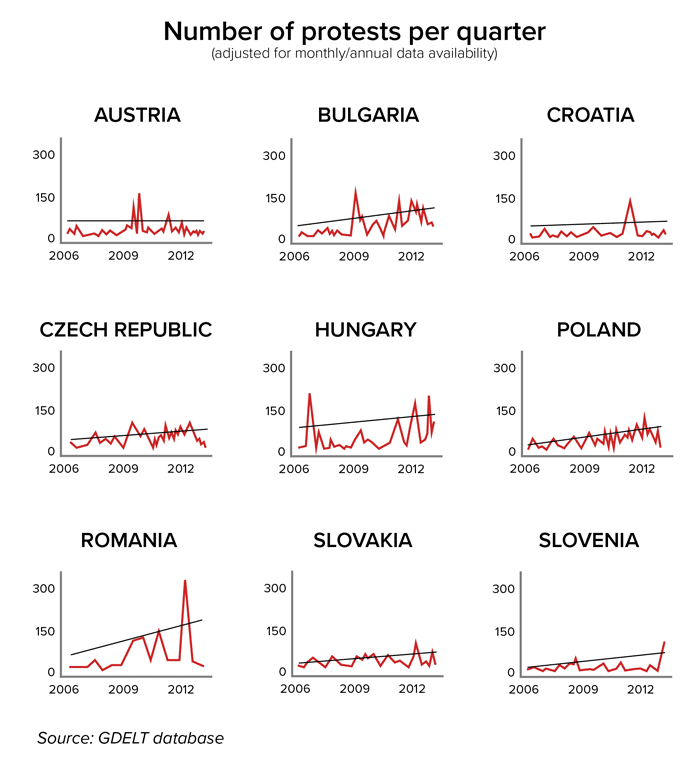The NGO sector in Eastern Europe is evolving, having to make up for the years lost during Socialism.
Volunteers from the West do not differ much from those in the East. They are often well educated, and they are younger and more affluent than average citizens. Moreover, they share similar biographies: those who start working early on have less time to engage in voluntary work. The situation is similar for people who become parents at a young age; they invest their time in their offspring. This is the same in Germany and in Bulgaria. What differs considerably, however, are the general conditions under which these people dedicate their hours to others without getting paid. The recent EU member states, but also the former Yugoslav countries in the Balkans, cannot ignore their past: in a region where community development used to be viewed with suspicion, if not fought against, for decades, where leisure activities were dictated by the Party – at women’s clubs, football clubs, in youth groups –, the ecosystem of volunteering must first establish itself.
The transformation process involves all sections of society, not only politics and business, where changes are evident. Changes to the social structure and social values – areas that are the glue that holds society together – are less visible, but no less crucial. In this respect volunteering is a new concept for post-communist societies. During socialism such values were organised from above or faked: for instance, when a company called on its employees to participate in the annual waste collection campaign or when they had to render unpaid service elsewhere for some higher aim. In countries such as Romania for example, even sports clubs used to be organised through companies. This legacy is still reflected in the current sector distribution of this region’s non-governmental organisations. The percentage of organisations in the sports and cultural sectors, particularly in the Visegrád countries, in Bulgaria, Romania and Croatia, is significantly higher than in Western Europe, amounting to 40 per cent. These are areas where personal commitment was at least tolerated by the regimes.
The increasing numbers of people volunteering in the region indicate that civil society has caught up in the recent EU member states and applicant countries as well. Despite difficult conditions in some areas, numbers have risen considerably over the past 20 years. While an average of 1.8 per cent of the working population was engaged in non-profit organisations in 1995, the figure has increased to three per cent today – which is 80 per cent more than in 1990.
Volunteering was encouraged not least by EU accession of individual countries or their endeavours to be part of the Union in future. The rights of minorities such as LGBTQ or the Roma and Sinti were often included in the negotiating package with EU officials and provided scope from then on. Owing to pressure from Brussels, rainbow parades are now also hosted by local initiatives in cities such as Bucharest and Belgrade. The fact that those in charge in Eastern Europe have learned how to benefit from it, appearing at such events for the sake of publicity to show themselves in a good light, is also part of the deal.
While an average of 1.8 per cent of the working population was engaged in non-profit organisations in 1995, the figure has increased to today.
While an average of 1.8 per cent of the working population was engaged in nonprofit organisations in 1995, the figure has increased to
3 per cent
today.
The awakening of the civic spirit is also apparent in political disobedience, which is not always factored in by the ruling parties. Central and Eastern Europe have seen the strengthening of civil society processes over the past few years. Think of the year-long protests in Bulgaria in 2013, which criticized the country’s political deficiencies and brought down two governments. In autumn 2016 crowds of people dressed in black brought down the Polish draft bill for the complete ban of abortion. Think of the mass demonstrations in Romania in the winter of 2017, when more than half a million people took to the streets to protest against attempts to weaken the judicial system (the protests continue), or Slovakia, where civil society strongly reacted to the murders of journalist Ján Kuciak and his fiancé.

These massive demonstrations made it to the news reports of European intelligence services. And people have also vented their anger at the local level: the joke party Magyar Kétfarkú Kutya Párt (“Hungarian Two-tailed Dog Party”), for example, has made it its task to parody Hungary’s political actors. Luka Maksimović, on the other hand, participated in the Serbian presidential election campaign as the satirical fictional politician named Ljubiša Preletačević “Beli” (“the white”). Aptly, he was often seen riding on a white horse during the campaign.
Original in German. Translated into English by Barbara Maya.
This text and infographics are published under the Creative Commons License: CC BY-NC-ND 3.0. The name of the author/rights holder should be mentioned as followed. Author: Eva Konzett / erstestiftung.org, infographics & illustration: Vanja Ivancevic / erstestiftung.org.
Cover picture: Volunteers fill bags with sand in Belgrade in May 2014 during the floods to be prepared for possible new flooding. Vienna Central Cemetery. Photo: © Ivan Milutinovic / EPA / picturedesk.com

Of People and Numbers – Eastern Europe in your pocket
Fourteen years have passed since the European Union set off towards the east. The initial euphoria first gave way to day-to-day life and has now turned into disillusionment on both sides. In some places people have become or remained strangers, despite visible and hidden relationships, and personal, official and business relationships. Despite the numerous similarities and the value chains that now know no borders. And sometimes precisely because of them.
Of People and Numbers aims to highlight the political, economic, cultural and social realities of life in the newer members of the EU and the accession states of South-Eastern Europe on a small scale and compare them to Western European realities, at least as they appear in Austria. Are the two really always miles apart? When does the view from above fall short?
When preconceptions are put aside, a different world emerges. Of People and Numbers brings this world to you in images, figures and words. A monthly serving of Eastern Europe. Delivered to your smartphone each month.